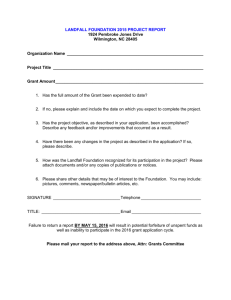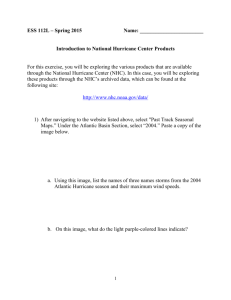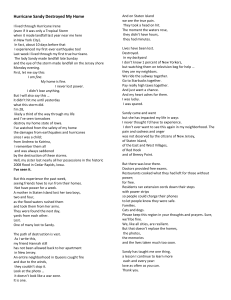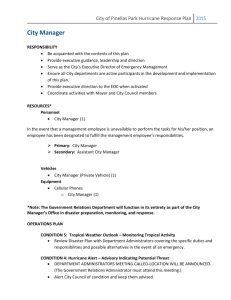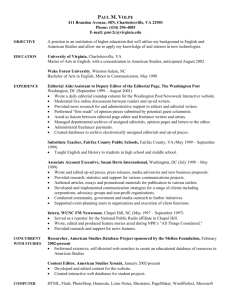Max Hailstone`s Landfall Covers
advertisement
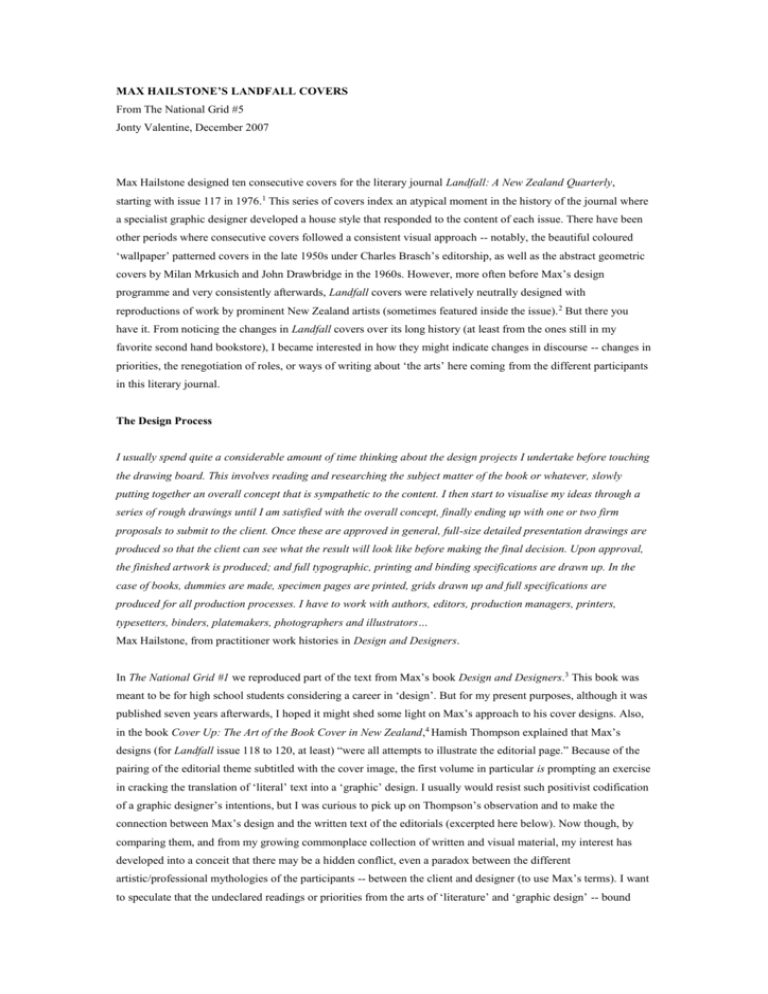
MAX HAILSTONE’S LANDFALL COVERS From The National Grid #5 Jonty Valentine, December 2007 Max Hailstone designed ten consecutive covers for the literary journal Landfall: A New Zealand Quarterly, starting with issue 117 in 1976.1 This series of covers index an atypical moment in the history of the journal where a specialist graphic designer developed a house style that responded to the content of each issue. There have been other periods where consecutive covers followed a consistent visual approach -- notably, the beautiful coloured ‘wallpaper’ patterned covers in the late 1950s under Charles Brasch’s editorship, as well as the abstract geometric covers by Milan Mrkusich and John Drawbridge in the 1960s. However, more often before Max’s design programme and very consistently afterwards, Landfall covers were relatively neutrally designed with reproductions of work by prominent New Zealand artists (sometimes featured inside the issue). 2 But there you have it. From noticing the changes in Landfall covers over its long history (at least from the ones still in my favorite second hand bookstore), I became interested in how they might indicate changes in discourse -- changes in priorities, the renegotiation of roles, or ways of writing about ‘the arts’ here coming from the different participants in this literary journal. The Design Process I usually spend quite a considerable amount of time thinking about the design projects I undertake before touching the drawing board. This involves reading and researching the subject matter of the book or whatever, slowly putting together an overall concept that is sympathetic to the content. I then start to visualise my ideas through a series of rough drawings until I am satisfied with the overall concept, finally ending up with one or two firm proposals to submit to the client. Once these are approved in general, full-size detailed presentation drawings are produced so that the client can see what the result will look like before making the final decision. Upon approval, the finished artwork is produced; and full typographic, printing and binding specifications are drawn up. In the case of books, dummies are made, specimen pages are printed, grids drawn up and full specifications are produced for all production processes. I have to work with authors, editors, production managers, printers, typesetters, binders, platemakers, photographers and illustrators… Max Hailstone, from practitioner work histories in Design and Designers. In The National Grid #1 we reproduced part of the text from Max’s book Design and Designers.3 This book was meant to be for high school students considering a career in ‘design’. But for my present purposes, although it was published seven years afterwards, I hoped it might shed some light on Max’s approach to his cover designs. Also, in the book Cover Up: The Art of the Book Cover in New Zealand,4 Hamish Thompson explained that Max’s designs (for Landfall issue 118 to 120, at least) “were all attempts to illustrate the editorial page.” Because of the pairing of the editorial theme subtitled with the cover image, the first volume in particular is prompting an exercise in cracking the translation of ‘literal’ text into a ‘graphic’ design. I usually would resist such positivist codification of a graphic designer’s intentions, but I was curious to pick up on Thompson’s observation and to make the connection between Max’s design and the written text of the editorials (excerpted here below). Now though, by comparing them, and from my growing commonplace collection of written and visual material, my interest has developed into a conceit that there may be a hidden conflict, even a paradox between the different artistic/professional mythologies of the participants -- between the client and designer (to use Max’s terms). I want to speculate that the undeclared readings or priorities from the arts of ‘literature’ and ‘graphic design’ -- bound together in the content and the cover of Landfall -- might not entirely translate or align. “And that’s what interests me, I guess, about this detachment/involvement: the push and pull of tone.” [See issue 122 excerpt below.] Problem Solving The Design process itself is very simple. If the role of the doctor in general practice is compared to that of the designer then it may become easier to understand. Normally a doctor cannot practice medicine without a patient. He cannot prescribe any treatment before he has ascertained the nature of the illness, by identifying the symptoms. This is achieved by questioning and examining the patient. The doctor then analyses the findings of his/her questions, examination and tests, and makes a diagnosis of the patient’s condition. Acting on this diagnosis he/she then prescribes treatment or medication to cure the problem. The designer is in much the same position. Normally he/she cannot practice design without a client. Like the doctor, the designer has to ascertain exactly what the problem is that the client wants solved. By questioning the client and examining the situation he/she will accumulate a considerable amount of information and will be able to analyse and establish exactly what the problem is that the client has. It is possible that the client, like the patient, may have identified the wrong problem: for example all stomach-aches do not require the removal of the appendix to provide the cure!! Being satisfied that the problem has been correctly identified, work can now commence on producing the solution. Max Hailstone, from ‘What is Design?’ in Design and Designers. The formal quality of all of Max’s graphic design was recognisably derived from the Swiss Typographic school -the modernist International Style that he brought to his teaching position at the University of Canterbury School of Fine Arts (Ilam) when he arrived from England in 1973. The drawing tools he used were distinctly modern too. Predominantly photography and phototypesetting combined by cut and paste and simplified using a bromide camera to produce finished art as line art (rather than halftone screen) images. All covers were printed in two colours. My initial impression was that Max had just imposed a 1960s Penguin-esque design style on the journal -an introduced iteration of covers inspired by Germano Facetti, Romek Marber, etc. 5 However, it is more a series of styles, with clear shifts in formal approach from one year’s volume to the next. For the first volume (issue 117 to 120) Max initiated the use of the serif typeface Baskerville Italic for all title text on the cover and spine. All text is centered with the masthead at the foot of the cover and the issue’s editorial theme is highlighted in inverted commas at the top of the page. This subheading acts as a label for the image below it. The images are illustrations -- pictorial representations of a literal metonymy, juxtaposition, metaphor, and analogy for the titles. ‘Outside from Inside’ is eyes looking through glasses, ‘Love sweet, Love sour’ a Dear John letter etc. For the second volume (issue 121 to 124) the subheading is abandoned, Baskerville is changed to Helvetica (oddly Max uses Univers on the spine), and the title text is grouped together and aligned left at the top of page. The drawings in this series are increasingly abstract. Max has done away with any pictorial elements and restricts the design to what he liked to call ‘extended typographic’ content.6 In issue 121 the lack of clear editorial subheading on the covers is reiterated (or prompted?) by the editorial being at the back of the journal, and by it not naming a clear theme. Although I could guess at a literal translation of the typographic compositions… issue 121’s cover is the list of contributor’s names repeated so it may reference to the fact that many are repeat contributors. Or reference to the (unnamed) editorial theme about expatriate New Zealanders who ‘move away’… But really the link between the image and the editorial content is lost in this volume. The visual content does not appear to be abstracted from the text. The ‘problems’ it was solving were directed towards an internal compositional/visual poetic -- a formal regime that I can’t help but read now as an intertextual reference to science or philosophy text books, from a time when it seemed that complex abstract ideas could only be represented by simplified geometric forms.7 The third volume, of which Max designed the first two (issue 125 and 126), presents another change in design. While still using all Helvetica on the cover, there is an increase in play and integration between text, image and issue number. The title Landfall is not treated as a logotype, but shifts to be integrated with the image -problematising the use of a masthead as a magazine’s primary indicator of identity. Max also introduces the use of large overlapping numbers that take up the lower half of the cover. Solution The question ‘What is design?’ may therefore be answered as follows: Design is a process. It is a process whereby a designer, equipped with a technical knowledge of all processes and materials available at the time, and a true understanding of the problems to be solved, and of the constraints that may be imposed upon the solution, together with a sensitive and humanitarian respect for the same, combines these different elements into a cohesive practical whole. Max Hailstone, from ‘What is Design?’ in Design and Designers. Peter Smart was the editor of Landfall during this period (actually from issue 116 through to 140). In issue 116, he pays tribute to past editors’ efforts to ensure that: “Landfall has tried to relate literature to the other arts and the general life of the country.”8 And goes on to reassure that: “For my part, I am anxious to keep the ship headed towards the first landfall, to look at the land in a way that Brasch and his friends first looked at it in 1947: literature must never be isolated from other arts, nor from the personalities and society which feed it; nor should our literature be isolated from other literatures, our writers from other writers who happen to live in other countries.” He expands on the theme of connection between the arts by proposing a change in editorial approach that may have presaged the new design approach that would begin in the next issue: “I propose to vary the programme of Landfall with each issue; one may be the mixture as before while another may specialise as this issue does [116 was on ‘Drama in NZ’]. Guest editors will widen contacts and give an important variety of approach. Other readerwooing strategies had best be left discreetly unrevealed, as all good New Year resolutions should be.” Against this indication that the literary community of Landfall were interested in the finding connections between art disciplines and between literature and general society (ie., inclusion) -- my reading of the visual arts community (ok, maybe I mean the (graphic?) design community) from this period, suggests an increase in differentiation of specialist areas (ie., exclusion). If Max’s covers stand as a metonymy for a moment of increased specialisation in graphic design for Landfall, they also index a period of increased ‘professionalisation’ from the design community as a whole. There seems to me to have been a renewed focus on the differences in readings or priorities of ‘graphic design’ from ‘fine art’ (and ‘craft’, ‘illustration’), and ‘literature’ at this time. Graphic Design was caught up in the emerging salvation narrative of design-in-the-service-of-industry, heralded by the launch of the government funded journal Designscape in 1969 (promoted under a banner of pseudo-scientistic ‘industrial design’), and followed up by an increase in activity to establish associational membership, product certification, quality ratification, etc. A key initiative from the NZ Industrial Design Council was to set up a ‘Design Index’ of approved designs/designers eligible to use the ‘Designmark’ label. Designers were invited “to submit for evaluation, products which they consider worthy of inclusion in Design Index.” [From Designscape 2, the ‘Think Print’ issue].9 I may be overstating the differences in the positions of the participants here for rhetorical effect, but the mythology of professionalisation and the scientification of design promoted by Designscape and echoed in Max’s writing (both published by the NZ Industrial Design Council), seems to imply a turn away from, an incompatibility with, or at least a tension between design and literary discourses. It was somewhere in between these divergent versions of artistic/professional practice that Max’s design contribution to Landfall was negotiated, but was also ended abruptly, mid-volume with issue 126, when it reverted back to artist-work covers. Notes 1 Landfall: A New Zealand Quarterly was conceived by Denis Glover and Charles Brasch. Brasch was editor for the first twenty years; 1947–1966. It was first published at Glover’s The Caxton Press and is now published by Otago University Press, Dunedin. 2 I realise this is a loaded way to start my text and many may (rightly) argue that The Caxton Press’s Denis Glover, Leo Bensemann and Co. were equally specialist graphic designers, and indeed that Max Hailstone was not only a graphic designer. I’m trying to avoid addressing this head on here, but my interest is in whether there was a renegotiation or hardening of modernist ideas of specialist practice -- and the differentiation of cultural spheres -- for this generation of (1970s) designers (that shows attitudes that were quite different to those of Glover’s generation). 3 Max Hailstone, Design and Designers. Christchurch: Griffin Press and NZ Industrial Design Council, 1985. 4 Hamish Thompson, Cover Up: The Art of the Book Cover in New Zealand. Auckland: Random House, 2007. 5 See Phil Baines, Penguin By Design: A Cover Story 1935–2005. Allen Lane: Penguin, 2006. 6 Here I am recalling student projects and class discussions with Max at Ilam. 7 See Dmitri Siegel, ‘Why Are All These Books Orange?’. Dot Dot Dot 8, 2004. 8 Smart is actually quoting Charles Brash here in his editorial. 9 Designscape: Monthly from the New Zealand Industrial Design Council. April 1969. –– Excerpts from Landfall Editorials Vol. 30, Number 117, March 1976: ‘Outside from Inside’ …This issue of Landfall has a selection of work which confirms that New Zealand writing is less insular and isolated than might be expected. Writers have always made real or spiritual journeys away from these islands -- Denis Glover’s recent attempt at redressing the imbalance of artistic trade caused by Russian circuses and ballet companies is simply one example. Even more significant are the arrivals: writers whose formative experiences have taken place in other countries who are now living and writing in New Zealand, as New Zealanders… Peter Smart [p3] Vol. 30, Number 118, June 1976: ‘Summer in Winter’ I began designing this issue with summer confidently in the front (mainly humour to supplement your dead or dying electric fires), and winter tucked away at the back (being mainly gloomy comments on our dead or dying society). But, like all our silly seasons lately, summer and winter don’t seem so very different when it comes to living them. They blur and surprise just as do laughter and tears, love and hate, believing and doubting… Peter Smart [p99] Vol. 30, Number 119, September 1976: ‘Feel the Quality’ Alan Loney at Hawk Press has initiated what may well emerge as a hopeful precedent in Small Press publishing in New Zealand. He has produced three books of poetry -- handset on fine papers and designed with intelligence and taste -- that merit considerable public attention and private support. These are books of quality in every respect… Michael Harlow, guest editor [p187]. The title on the cover, and what appears to be the actual editorial theme for this issue, is ‘Love sweet, Love sour’. Vol. 30, Number 120, December 1976: ‘Imagination’ As a working ‘touchstone’ for thinking and talking about creative activity, imagination is as elusive a concept as it is perhaps one of essential convenience. Attempts to ‘define’ imagination are legion in the history of literature as well as philosophy and science. Such attempts are heroic, but ultimately I think destined to flexibility in the extreme. Yet -- we persist, perhaps for the same reasons we unendingly dwell on and ponder the nature of other abstractions: love, spirit, the soul, deity, matter. There appears to be a psychic need to attempt a definition of those feelings and forms that shape and control language as well as artistic activity… Michael Harlow, guest editor [p283] Vol. 31, Number 121, March 1977: ‘Editorial Notes’ … Previous editors of Landfall have been reluctant to publish work from non-New Zealanders. While agreeing that a national magazine is primarily for New Zealanders, I also believe that if other writers want their voices heard in New Zealand, then readers and writers here are likely to find some stimulus from the interchange. Future Landfalls will therefore carry a small proportion of ‘imported’ writing which has been written for, rather than by, New Zealanders… Peter Smart [p95] Vol. 31, Number 122, June 1977: ‘A Survey’ The main feature of this month’s Landfall is a survey, conducted over the last few months, of the interrelationship between creative and critical writers and audiences in New Zealand at the moment… Rob Jackaman, guest editor [p99] Dear Rob Jackaman, … I tried your topics and they drove me to distraction. I gave three a go. ‘Do you generally aim for authorial involvement or detachment in your work?’ You do ask personal questions, he said. Or, will you go on: Do you generally aim to create characters and/or symbols? To the best of my knowledge I have never experimented, I know how it stunts the growth, drives you blind… I can’t relate to your language, Rob Jackaman. Academic, market research. Ask me what time it is. What I think of consonants. What (in the world) have we come to. Ask me: in your writing or, in the case give space to experimental both? And I’d have to say yes. Oh yes, yes… In your introductory comments I find you don’t say what you’re interested in. It’s in the tone. And that’s what interests me, I guess, about this detachment/involvement: the push and pull of tone. Wystan Curnow, in answer to Rob Jackaman’s survey [p108] Vol. 31, Number 123, September 1977: ‘Myths in the Making?’ The thirteen stories in this issue were chosen from well over a hundred stories submitted this year to Landfall. Some are by established writers, but others are very young, and very old, newcomers to public scrutiny. All the stories have in common the ability to suggest something larger than their immediate concerns: this ‘something larger’ often looks like a myth in the making. Those who made the old myths, the ancient myths, were also storytellers. But they had other functions in society than mere storytelling or entertaining. They were the priests, historians, philosophers and prophets of their age. It seems to me, reading through what must be a considerable sampling of what is being written by New Zealanders, that our writers are not unaware of similar roles. I can certainly distinguish four interesting categories which I call the Confessors, the Philosophers, the Prophets, and the Magicians… Peter Smart [p195] Vol. 31, Number 124, December 1977: ‘Christmas Greetings and New Year Resolutions’ It has been an exciting year’s reading for those of us who have read the many stories, poems and articles submitted for publication. We already have enough copy for the first two issues next year, although in order to achieve a balance and topicality we have not yet finalised either March or June issues. Lauris Edmond of Wellington will be the guest editor for the March issue, some evidence of our resolve to extend Landfall geographically and sexually in the New Year… Michael Harlow, Peter Smart [p291] Vol. 32, Number 125, March 1978: ‘Writers Under Stress’ New Zealand representatives of the 42nd Congress of P.E.N. International, held in Sydney last December, returned home filled with the urge to persuade writers here to take up the cause of exiled, imprisoned or otherwise harassed fellow writers in other parts of the world. In Indonesia, in Korea, in Chile, in the USSR and Eastern Europe and in many other places -- the list, and the area of the globe so affected, is growing -- those who try to publish work shaped by independent and controversial opinion are silenced. In Vietnam alone, since liberation, hundreds of writers have been arrested and sent to unknown destinations… Lauris Edmond, guest editor [p3] Vol. 32, Number 126, June 1978: ‘The Use of Childhood’ Rousseau’s young Emile was a blank page upon which experience could write; and before him there were very few, if any, children in literature. Then, still only two hundred years ago, Blake’s children sang their brief songs of innocence before turning to the sad songs of experience. Wordsworth’s sensitive, vulnerable young came ‘trailing clouds of glory’ from God, to father men upon whom the prison doors soon shut. Dickens had a more balanced repertoire, but the young were usually sufficiently sinned against to justify their own subsequent sinning -- if they didn’t manage to escape by dying. Through the horrors of the industrial revolution, the first hundred years of literary children were original innocence personified, as if they were symbols of a nation which had turned its back on its own childhood… Peter Smart [p99] –– Maxwell John Hailstone (1942–1997) Educated in England. Left school at 17 with GCE Art (University Entrance). 1959–1963 Studied Graphic Design at Leicester College of Art, full-time. Graduated with National Diploma in Design (NDD). 1963–64 Studied Typogaphic Design a Post Graduate course at London College of Printing (LCP). 1964–66 Book designer with Macmillan & Co. Ltd publishers, London. 1966–68 Research Fellow, Institute of Advanced Studies, Manchester (ADF (Manc)). Set up Design Partners, (a graphic design studio with Jonas Cleary). 1968–73 Lecturer at Liverpool College of Art. 1973– FT. Lecturer at University of Canterbury. 1981– Director of Griffin Press, Christchurch. At all times maintaining a steady flow of freelance and consultative work. [From hand written vita, in manuscript for Design and Designers.]
